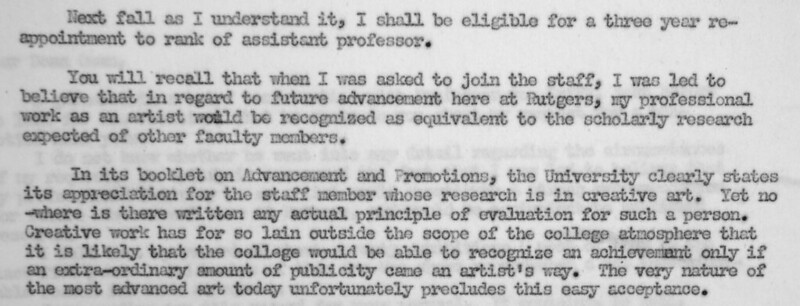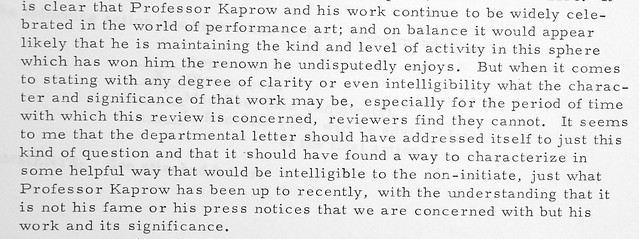
Allan Kaprow – University lecture notebook from the 1940s (Getty Archive)
I’m in Vancouver right now. Recently Lizzie, Albie and I visited L.A., San Diego, San Francisco, and Portland. I’m pursuing the intersections between socially engaged art practice (and its pre-histories) and environmental management situations, as I try to work out how best to press on with Sugar vs the Reef.
In L.A., the Getty squeezed me in for a preview of some of Allan Kaprow’s archives which are housed there. I wasn’t able to spend days and days rummaging through Kaprows’ stuff, so it was more of a “triage”, to work out whether it’s worth coming back for a longer visit.
And it would be worth it for sure. Here’s a brief excerpt from the spiel about the Kaprow Papers:
The Allan Kaprow Papers offer comprehensive documentation of an artistic career that spanned the latter half of the 20th century and continues into the 21st. Arranged chronologically so as to demonstrate the artist’s passage from student of art and art history to practicing artist, art theorist and art educator, the collection contains drawings, term papers and notebooks from Kaprow’s student days, followed by ca. 250 Project Files, comprising the complete extant documentation of Kaprow’s Environments, Happenings, and Activities.
There’s loads of stuff in there that hasn’t seen the public light of day, not to my knowledge at least – including many video tapes documenting Happenings, and unedited audio tapes from Kaprow’s public talks and lectures.
I had limited time, so I dived in to one aspect of Kaprow’s work that I have always been interested in, but which isn’t widely known about – his relationship to university teaching and research. As the Getty description shows, there is a lot of “meta” stuff in these papers – relating to Kaprow’s sometimes troubled life as an employee:
[Kaprow’s] Teaching Files contain correspondence with university officials and colleagues; together with Professional Correspondence they portray the financial difficulties attendant on an unconventional art career that has taken place outside the usual venues and generated few objects that could be sold for profit.
Now, prior to this visit to the Getty, if you’d have asked me about Kaprow’s teaching work, I would have answered thus:
- Teaching was very important to him;
- Kaprow often involved students in his Happenings, so there was a blurring between his teaching work and his public art projects;
- In the 1970s, Kaprow withdrew from making public Happenings, which he felt had become too spectacularized (if that is a word), moving instead towards private “Activities” – interactions between very small groups of individuals (sometimes two, sometimes just one). This withdrawal from public Happenings coincided with an increased dedication to teaching as a practice in its own right. In other words, he shifted his energy from making art for the artworld, to training “un-artists” within the university system.
Points one and two seem pretty solid. However, my look through Kaprow’s university files at the Getty quickly broke down my mythologising (in point 3) about his 1970s shift from public art work to education work. What I found instead was that right from the beginning, and continuously until the 1980s at least, the money and prestige associated with working as a lecturer at universities was of great importance to Kaprow. But he struggled to get the recognition that he felt he deserved.
In the early 1950s, Kaprow’s letters reveal that he was very keen to get university teaching work. Much of the correspondence from that period (at Rutgers University) involves requests that the administration confirm whether or not he would be engaged to teach the following year. Throughout the 50s, Kaprow worked on a series of disconnected one-year contracts, and his letters carry a lot of frustration about not knowing whether he’d be employed come the end of summer.
There were also a bunch of letters to his Rutgers head of department, where Kaprow argues the case for his promotion from “instructor” to associate professor. His argument for promotion was based around the idea of equivalence between creative practice and standard scholarly achievement – for example, that a “one man show” (as it was called back then) was the equivalent of a book publication. This is exactly the sort of quantification problem that goes on within Australian universities today, and remains largely unresolved. Kaprow’s letters sounded very fresh in this regard. And, just like today, it seems that he had to work extra hard to make his case within an institution that was only set up to accept traditional scholarly outcomes as research:
Creative work has for so [long] lain outside the scope of the college atmosphere that it is likey that the college would be able to recognize an achievement only if an extra-ordinary amount of publicity came an artist’s way. The very nature of the most advanced art today unfortunately precludes this easy acceptance.

Allan Kaprow, letter to Helmut (Kaprow’s department head), July 24, 1958 (Getty Archives)
Later, in the 1980s when Kaprow was at UCSD, correspondence with university executives (again about a potential promotion) centred around the problem of how Kaprow’s performance art could be effectively communicated beyond the boundaries of the discipline.
It seems that the Vice Chancellor of Academic Affairs, John Miles, had knocked back Kaprow’s formal application for promotion. For Miles, what was lacking was a layman’s explanation of specialist art practices. A non-specialist explanation would enable these practices (which these days we’d call “creative practice based research”) to be understood, and judged, outside the narrow confines of the university art department. Miles writes:
It is clear that Professor Kaprow and his work continue to be widely celebrated in the world of performance art; and on balance it would appear likely that he is maintaining the kind and level of activity in this sphere which has won him the renown he undisputedly enjoys. But when it comes to stating with any degree of clarity or even intelligibility what the character and significance of that work may be […] reviewers find that they cannot.
Miles goes on to point out what he felt was lacking in Kaprow’s application for promotion:
[the application] should have found a way to characterize in some helpful way that would be intelligible to the non-initiate, just what Professor Kaprow has been up to recently, with the understanding that it is not his fame or his press notices that we are concerned with but his work and its significance.

John Miles (Vice Chancellor of Academic Affairs), letter to Prof. Moira Roth, (Chair Dept of Visual Arts) August 11, 1982 (Getty Archives)
Kaprow responds:
It is simply outside the limits of the CAP’s [Committee on Academic Personnel] and John Miles’ academic responsibilities to ask this department for a layman’s guide to performance art, just as it would be improper to ask the Biology Department for a layman’s guide to genetic engineering.
If acceded to, CAP and Miles would shift from being reviewers to judges of fields in which they might have no expertise. This would run squarely against the academic tradition of peer evaluation.

Allan Kaprow, letter to Phil Steinmetz, Acting Chair Visual Arts Dept, UCSD, August 31, 1982 (Getty Archives)
My time at the Getty ran out before I could determine the outcome of this epistolary stoush. In retrospect, it seems of minor importance – Kaprow was already a Professor, and the promotion application was merely to determine whether he would move one more step up the Professorial rung. But these letters from the 1950s to the 1980s do reveal that prestige and money – or perhaps simply “credit where credit’s due” – really did matter to Kaprow.
More importantly, Kaprow’s trail of bureaucratic correspondence points to the problem of how art work can be accommodated within the academic environment. By 2015, this problem has been somewhat addressed with the exegetical model for the creative practice based PhD, and the application of a metrics to judge how many brownie points an exhibition or performance is “worth” as research.
But many of us who do this kind of creative research within the university system will be aware of the continually uncomfortable fit. What is gained, and what is lost, when creative practice is made fungible in this way?
…a few breadcrumbs for me to follow up later on:
1.
this book by James Nisbet: Ecologies, Environments, and Energy Systems in Art of the 1960s and 1970s, MIT Press, 2014. From the precis, it seems that Nisbet makes a link between Kaprow’s early work described as “environments”, and later concerns by land artists with ecological and environmental contexts for their practices.
2.
this essay by John Perrault, entitled “Allan Kaprow: The Retread”, which touches on the Kaprow papers housed at the Getty Archives, as well as the “re-treads” (re-enactments or re-doings) of his work by others. I hadn’t known it before, but Kaprow was adamant that he should not be consulted on these. Rather, licence should be taken by a “leader” to make the necessary decisions to bring the work to life in the present. Perrault quotes Stephanie Rosenthal:
3.
this essay by Géraldine Gourbe, entitled “The Pedagogy of Art as Agency: Or the Influence of a West Coast Feminist Art Program on an East Coast Pioneering Reflection on Performance Art’.